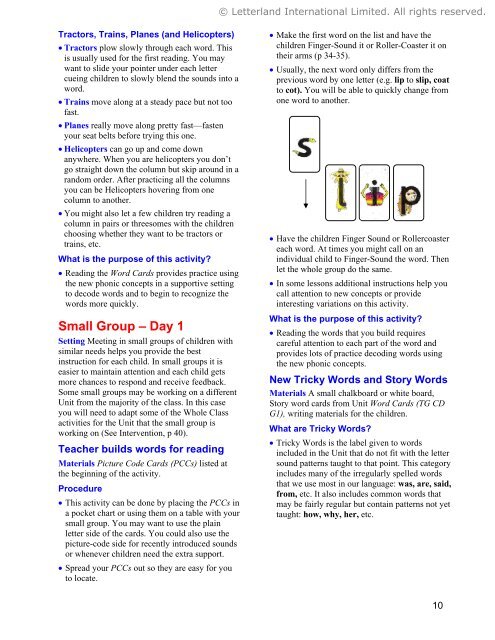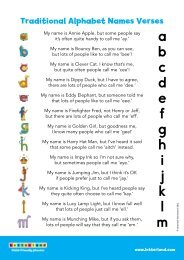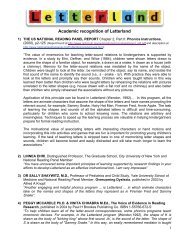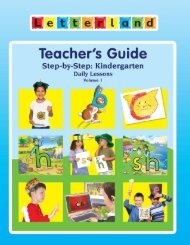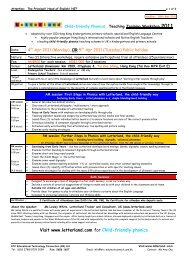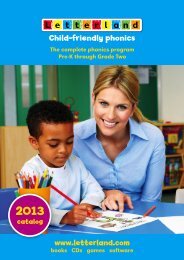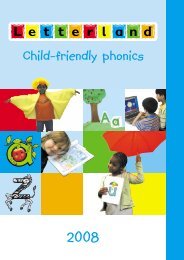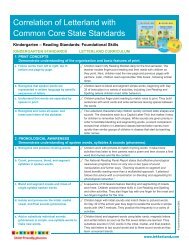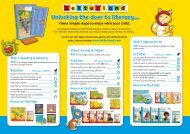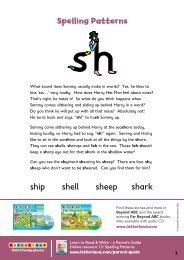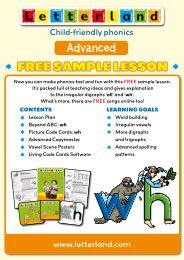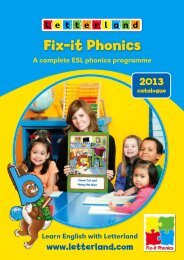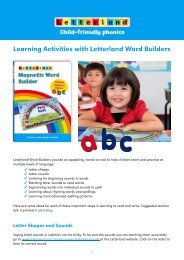Teacher's Guide - Letterland
Teacher's Guide - Letterland
Teacher's Guide - Letterland
Create successful ePaper yourself
Turn your PDF publications into a flip-book with our unique Google optimized e-Paper software.
© <strong>Letterland</strong> International Limited. All rights reserved.Tractors, Trains, Planes (and Helicopters)• Tractors plow slowly through each word. Thisis usually used for the first reading. You maywant to slide your pointer under each lettercueing children to slowly blend the sounds into aword.• Trains move along at a steady pace but not toofast.• Planes really move along pretty fast—fastenyour seat belts before trying this one.• Helicopters can go up and come downanywhere. When you are helicopters you don’tgo straight down the column but skip around in arandom order. After practicing all the columnsyou can be Helicopters hovering from onecolumn to another.• You might also let a few children try reading acolumn in pairs or threesomes with the childrenchoosing whether they want to be tractors ortrains, etc.What is the purpose of this activity?• Reading the Word Cards provides practice usingthe new phonic concepts in a supportive settingto decode words and to begin to recognize thewords more quickly.Small Group – Day 1Setting Meeting in small groups of children withsimilar needs helps you provide the bestinstruction for each child. In small groups it iseasier to maintain attention and each child getsmore chances to respond and receive feedback.Some small groups may be working on a differentUnit from the majority of the class. In this caseyou will need to adapt some of the Whole Classactivities for the Unit that the small group isworking on (See Intervention, p 40).Teacher builds words for readingMaterials Picture Code Cards (PCCs) listed atthe beginning of the activity.Procedure• This activity can be done by placing the PCCs ina pocket chart or using them on a table with yoursmall group. You may want to use the plainletter side of the cards. You could also use thepicture-code side for recently introduced soundsor whenever children need the extra support.• Spread your PCCs out so they are easy for youto locate.• Make the first word on the list and have thechildren Finger-Sound it or Roller-Coaster it ontheir arms (p 34-35).• Usually, the next word only differs from theprevious word by one letter (e.g. lip to slip, coatto cot). You will be able to quickly change fromone word to another.• Have the children Finger Sound or Rollercoastereach word. At times you might call on anindividual child to Finger-Sound the word. Thenlet the whole group do the same.• In some lessons additional instructions help youcall attention to new concepts or provideinteresting variations on this activity.What is the purpose of this activity?• Reading the words that you build requirescareful attention to each part of the word andprovides lots of practice decoding words usingthe new phonic concepts.New Tricky Words and Story WordsMaterials A small chalkboard or white board,Story word cards from Unit Word Cards (TG CDG1), writing materials for the children.What are Tricky Words?• Tricky Words is the label given to wordsincluded in the Unit that do not fit with the lettersound patterns taught to that point. This categoryincludes many of the irregularly spelled wordsthat we use most in our language: was, are, said,from, etc. It also includes common words thatmay be fairly regular but contain patterns not yettaught: how, why, her, etc.10


